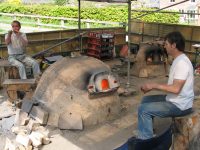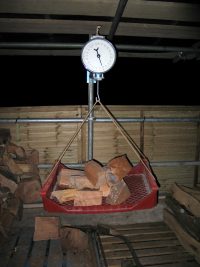

Introduction ('Home')
Glassworking Phase
General Photographs
Pot Furnace Photographs
Tank Furnace Photographs
Annealing Oven and Glass Photographs
Glassblowing Photographs
On 26th April, 2005, both furnaces were lit with the intention of running them at low temperatures for two days. At the end of this period, the temperatures were slowly raised over a further two days to about 1050°C and the glass was introduced. Four of the pots in the pot furnace had survived the heating, but one had developed a leak which prevented its use. We still had enough glass to work with, even though another pot developed a leak near the end of the firing. However, the tank in the tank furnace split open during initial firing, rendering it unusable. Notwithstanding this, on 1st May, using the pot furnace, we started to blow glass.



The overriding observation was that teamwork was the most important consideration. The back-up crews of stokers (doubling as wood-gatherers) were essential (and we are extremely grateful to the people who volunteered their time - on both night and day shifts), and their communication with the glassblowers was very necessary.
The pot furnace in particular ran well at between 1000°C and 1060°C in the pot chamber, but to raise the temperature above 1100°C was hard work, so it was usually kept to these limits.
The glass we used was one that reproduced the composition of Roman glass. We found that it needed a night-day-night cycle at temperatures above 1000°C in order to be ready for blowing. This length of time produced a glass quality comparable with original Roman glass, with small bubbles (seed) still present, but kept down to acceptable levels.
The tank furnace was still needed to run the oven, so a cycle of dropping the temperature at night to 600°C and raising it during the day to about 1000°C - 1050°C was evolved. The night stokers cooled the oven down, removed the previous day's glass and re-heated the oven in readiness for the coming day.

Wood was weighed in ten kilo batches, and the amount burned was recorded for both furnaces:
Several species of wood were used, including beech, ash, walnut, chestnut and yew.
Glassblowing itself was a voyage of discovery! Skills had to be adapted and developed to cope with conditions such as working close to the furnace, using the gathering hole for reheating, using short, thin gathering and blowing irons and working with several irons at a time.
In addition, one had to cope with the wind blowing hot gases into one's face. This is a very good argument for inferring that ancient furnaces were enclosed in substantial shelters!By the end of the glassworking phase of the project, the vessels were much improved on those blown at the start of this phase, and the luxury of more time would have resulted in a wider variety of vessels and more precise control of the glass.
"If you build it, they will come."